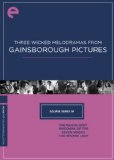| Reviews & Columns |
|
Reviews DVD TV on DVD Blu-ray 4K UHD International DVDs In Theaters Reviews by Studio Video Games Features Collector Series DVDs Easter Egg Database Interviews DVD Talk Radio Feature Articles Columns Anime Talk DVD Savant Horror DVDs The M.O.D. Squad Art House HD Talk Silent DVD
|
DVD Talk Forum |
|
|
| Resources |
|
DVD Price Search Customer Service #'s RCE Info Links |
|
Columns
|
|
|
Eclipse 36: Three Wicked Melodramas from Gainsborough Pictures
THE MOVIES:
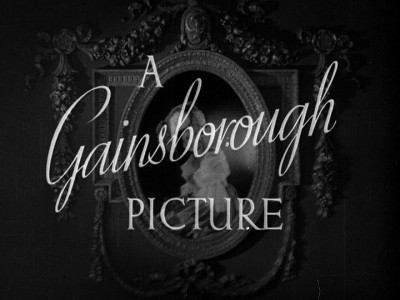
Gainsborough Pictures, I'll admit, is not a company I had heard of, despite the fact that they produced Hitchcock's The Lady Vanishes (and, indeed, were instrumental in encouraging the master of suspense's early career). Formed in 1924, they spent most of their first two decades struggling to get a foothold in the British film industry. It wasn't until the wartime period, when the studio switched owners and also picked up distribution through J. Arthur Rank, that Gainsborough found its footing. The title of this boxed set, Three Wicked Melodramas, fairly succinctly details what that footing was. Costumed romances and gothic potboilers became the Gainsborough signature. If one were to argue that, say, Ealing was the English equivalent of Warner Bros., producing a lot of respected mainstream fare, then Gainsborough was RKO, a place to make energetic B-pictures that could also be artful crowdpleasers.
The major turning point for Gainsborough came in 1943, when the studio released Leslie Arliss' The Man in Grey (116 minutes). In Hollywood, The Man in Grey would have been dubbed a woman's picture, as it's a hearty mix of romance and soap opera, doomed love and shattered dreams, with costume and setting playing an important role in the psychological drama being portrayed. Indeed Arliss co-wrote the script with Margaret Kennedy, and they were working from Doreen Montgomery's adaptation of Lady Eleanore Smith's novel. If any crew of writers were set to know what women might want to see at the cinema, it was this one.
Except for a bookend sequence set in modern times, which envelopes the tale in such a way to emphasize its theme that some love is fated to be, The Man in Grey's narrative is set in the early 19th Century. Phyllis Calvert plays Clarissa, an heiress to a modest fortune, who makes a move up the social ladder when she marries the mysterious Lord Rohan, a gadabout who is expected to carry on the family line, but whom has no real interest in conventional living. Lord Rohan is played by a fiery James Mason, and represented a breakout role for the actor. He accepts an engagement with Clarissa because he sees her blandness as the path of least resistance. Once she bears him a son, they begin to split their time between separate homes, with the Lord raising their child away from his mother.
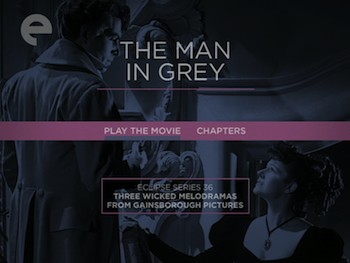
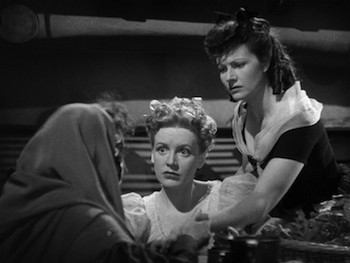
This leaves Clarissa alone to occupy herself as she will. On a night out at the theater, she spots her old schoolmate, Hesther (Margaret Lockwood), who ran away from the girl's school after a gypsy (Beatrice Varley) refused to read her palm, sensing that a great evil existed in this woman. The same fortune teller warned Clarissa that Hesther would also be her doom, but as is often the case with romantic heroines, Clarissa is loyal to a fault. Seeing that the life of a traveling actress is doing her friend no good, Clarissa invites Hesther to stay with her. At the same time, the kept wife falls for Hesther's acting partner, the rogue Peter Rokeby (Stewart Granger). Peter is many things--a thespian, a highwayman, an auctioneer--but behind the rakish exterior lurks a nobleman in exile. He and Clarissa begin an affair, while Hesther sets her sights on Lord Rohan. Tragedy will soon follow.
It's kind of a corny, well-worn story, but as with all the best melodramas, the plot is not as important as the tone of the piece. The true pleasure of The Man in Grey is in how Leslie Arliss wholeheartedly and unpretentiously embraces the lustier aspects of the material. Indeed, there is something refreshing in how matter-of-factly the story handles its more scandalous elements. Though more sensual than overtly sexual, one has little doubt that sex is at work here. With it comes the ever-present threat of violence, not just amongst the men, but in Hesther's murderous plans and Lord Rohan's barely contained rage. Indeed, there is some lady slapping. There is also a casual racism that is presented as utterly normal, including a young servant boy (Harry Scott) who is clearly a white actor in blackface. Even this is somehow absorbed into the heated atmosphere. Arliss has dropped his characters into a social oven, and he's going to bake them until they deflate or explode. Given the fates of both Clarissa and Hesther, and the limited options available to them, one could easily make a case for The Man in Grey being more than a simple bodice ripper: it's a film that comments on the role gender plays in society, while toying with the myths of the Byronic hero. (The servant boy, alas, gets no such subtext: he ends up being a plot device, pure and simple.)
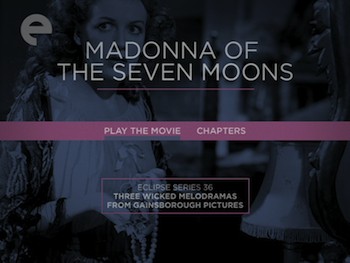
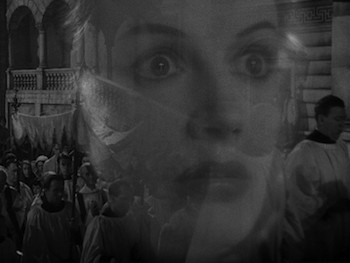
There is nothing pure nor simple about 1945's Madonna of the Seven Moons (110 mins.), a film that is as fevered and crazy as its heroine. Directed by Arthur Crabtree (Fiend Without a Face), and adapted by Roland Pertwee (Michael Powell's The Spy in Black) from a novel by Margery Lawrence, this film purports to detail a condition proven by medical history, though the veracity of the details strike me as questionable.
In this pre-WWII drama, Phyllis Calvert returns to play Maddalena, an Italian woman who, as a girl, was raped while picking flowers in the field. The trauma has haunted her ever since, and caused her to develop a split personality. In her everyday life, she is the pious wife of a nobleman (John Stuart); when she is having one of her episodes, she is Rosanna, the lover of the petty thief Nino (Stewart Granger). Maddalena's teenaged daughter, Angela (Patricia Roc) has been away at school for many years, and so has been kept unaware of her mother's illness. When the girl returns, flaunting her modern ways and bringing along her modern friends, including the oily grifter Sandro (Peter Glenville), Nino's little brother, the landscape suddenly gets crowded and, dare I say, secularly inclined. Overcome by all the stimulus, Maddalena succumbs and Rosanna takes over. She returns to Nino, leaving only a symbol of seven moons drawn on the mirror as any hint of where she's gone.
Madonna of the Seven Moons is a bit of a mess in terms of narrative. A large cast of characters whirl around Maddalena, each with their own purpose and subplot. There is Angela's fiancé Evelyn (Alan Haines), and his friend Logan (Peter Murray Hill), the painter who inadvertently sketches in the same criminal slum where Rosanna shacks up with Nino. Rosanna also has her own rival (Jean Kent), the girl who took her place in Nino's bed while she was away. There are a pile of secrets to be exposed: Rosanna's true identity; Sandro's true identity; Nino's plot against Rosanna's husband, whom he jealously believes stole his woman. Eventually, Nino and Sandro hatch a plan to ruin the whole family. Nino will rob the house and kill Guiseppe, and Sandro will lure Angela away, drug her, and have his way with her--subjecting her to the same fate as her mother when Maddalena was her age.
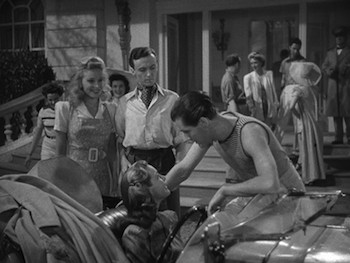
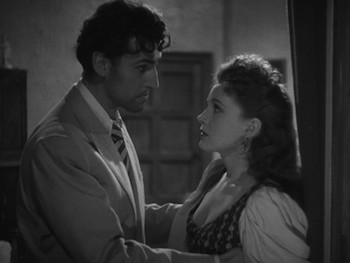
Naturally, all of this envelopes the fragile woman, and Maddalena/Rosanna cracks again. In both identities, she is prone to mad fits and fainting spells, triggered by musical cues and familiar sites (including, later in the movie, when she's broken bad, a religious procession that sends her into a breathless tizzy). Calvert goes for broke in these moments. Her mad eyes and fraught expressions predict Norma Desmond's breakdown in Sunset Boulevard. It's actually an impressive performance during the more level scenarios. The actress makes the two halves of the personality distinctive, in appearance and demeanor as much as behavior. There are light years between the buttoned-up housewife and the bawdy mistress.
Crabtree manages to keep all his balls in the air, and he lets them drop at the right moment. Though the story wanes at times, the overall tone of the picture has a lurid exaggeration, as if every frame were panting from the internal heat. Also, the finale is well worth any drag getting there. In the final confrontation, Maddalena exorcises her demons, but with a price, and lessons are learned all around. Even the dastardly Nino is given pause to reflect on his bad self. The Madonna of the title manages to sacrifice herself for her daughter's life education, giving Angela time to correct her own wicked ways before it's too late. If only Maddalena had better gadar and could give the girl a heads up about what Evelyn may not even be admitting to himself...
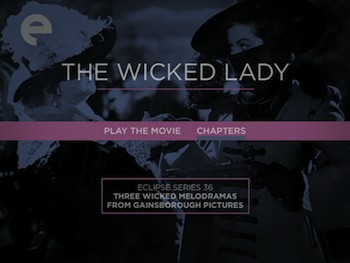
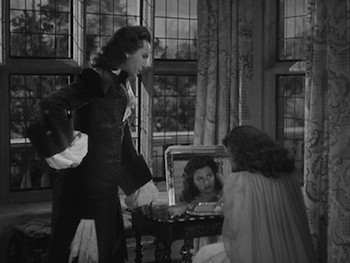
The Wicked Lady (1945; 104 mins.) reunites stars James Mason and Magaret Lockwood with writer/director Leslie Arliss to adapt a novel by Magdalen King-Hall. It's my favorite film in the Three Wicked Melodramas from Gainsborough Pictures set, and unsurprisingly, also the studio's most commercially successful during their run of pulpy romances.
Lockwood stars as Barbara Worth, a headstrong woman making her way in 17th-century England. Barbara is the sort of woman who has learned the hard way that if she wants something, she needs to take it. And so it is that at the outset of The Wicked Lady, she steals a husband directly from another bride. When they first meet, Sir Ralph Skelton (Griffith Jones) is due to marry Barbara's best friend, Caroline (Patricia Roc again), but pretty soon Barbara has turned the man around and gotten him to switch fiancées. Too bad for him that, by Barbara's own admission, as soon as she has a something she covets, she no longer wants it. At the wedding reception, she is romanced by Kit Lockley (Michael Rennie), and she'd just as soon run off with him as dance off to her honeymoon.
Alas, such romantic adventures are not to be, and Barbara soon becomes bored at the Skelton estate, far from London, in the province where Sir Ralph serves as judge. After a particularly catty card game with Ralph's sister (a delightfully bitchy Enid Stamp Taylor) in which Barbara loses the brooch that is the last connection she has to her late mother, the scorned woman takes the drastic measure of pretending to be a highway robber and stealing it back. Liking the thrill of crime, Barbara makes night-time hold-ups her new hobby. This leads her to run into the real crook working the territory, Lucky Captain Jackson (Mason), a scoundrel known to empty a man's pockets and then kiss his wife for good measure. Jackson is amused to have female competition, and the two become partners...and lovers.
Of all the movies here, The Wicked Lady makes the most of the subtext of the bored wife finding entertainment outside the home. Whereas Clarissa in The Man in Grey was matching her husband tit-for-tat in seeking happiness beyond the marital arrangement, and Maddalena invented a whole other persona to explore her sexuality in Madonna of the Seven Moons, this wicked lady is closer to self-actualizing. She is choosing to be as she is, and enjoying assuming the male role (her victims all think there is a man behind that gun and mask). In a sense, she is akin to the femme fatale of film noir, and eventually she will have to be neutralized as punishment for stepping outside the boundaries. Indeed, the last shot of Barbara has a bleakness worthy of the best noir, and The Wicked Lady would have been even better had Arliss cut the two small scenes that follow. No one really cares whether Ralph or Caroline are happy. Our allegiance is to Barbara.
And that's despite the terrible things she has done. In defiance of Jackson's warnings that killing a man will erase all hope of mercy if caught, Barbara ends up shooting a courier, albeit accidentally. Once she has crossed the line, she has even more reason to protect her secret, not to mention a taste of death. Subsequent murders become both easier and deliberate. There is an inevitable decline of a criminal enterprise, and outlaw stories hinge on our still rooting for the bad guy. It's pretty easy to do here, because Margaret Lockwood is clearly having so much fun playing the horse-riding thief. James Mason, too. Both launch themselves into the roles with absolute abandon, though Mason practically runs away with the whole thing in his grandstanding scene at the gallows.
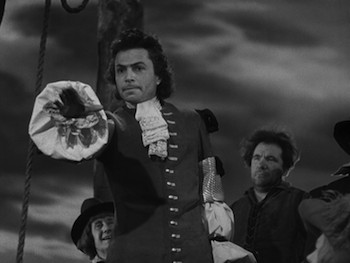
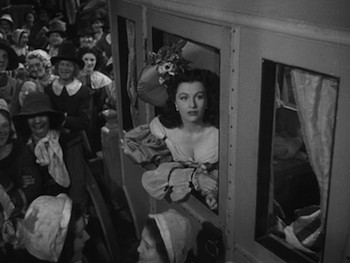
Both Madonna of the Seven Moons and The Wicked Lady were shot by cinematographer Jack Cox. (It should be noted, The Man in Grey was actually shot by Madonna's director, Arthur Crabtree.) Both films are stylish, but there is something just a tad more thrilling about the look of The Wicked Lady. It is most likely the swashbuckling excursions, and the chance to photograph masked riders against a night sky. Yet, that aforementioned shot where Barbara is abandoned to herself works largely because of how Cox pulls his camera not just away from the subject, but up from the floor and out a window. There is a vivaciousness to The Wicked Lady, suggesting it's not just the two main stars who threw caution to the wind during the production, but the entire team of artisans pulling this lark together.
Moviegoers of the 1940s (and indeed, the 1930s and 1950s, if not all decades) were particularly hungry for entertainment, and movies were being churned out across the world at a fairly rapid pace. A good portion of those came and went just as fast, and while there are certainly more artful films than the ones in Three Wicked Melodramas from Gainsborough Pictures, this trio endures because of the undeniably base pleasures they offer. These Gainsborough efforts were lusty and vivid and unafraid of pushing the boundaries of taste, in ways closer to pre-Code Hollywood than their American counterparts from the same period. Sex, violence, betrayal, romance, tragedy--all the dangerous ingredients of escapism. Not just dangerous, but essential. And timeless. Indulging the wrong impulses through the vicarious buzz of cinema is always going to be pleasurable, and that means movies like these never go out of style.
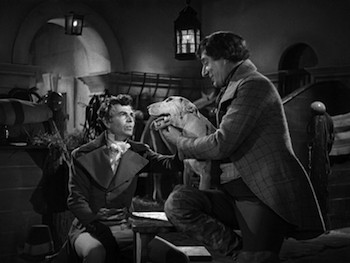
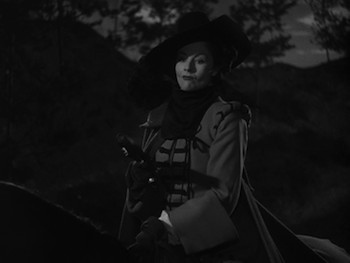
left to right: The Man in Grey, The Wicked Lady
THE DVD
Video:
The trio of black-and-white films collected in Three Wicked Melodramas from Gainsborough Pictures are shown in their original 1.33:1 aspect ratio. The presentations here vary from the mostly good to the consistently solid. The prints used are not perfect, with instances of scratching and dirt that, while never enough to obscure the frame or ruin the viewing, are not on par with bigger home video restorations. The Man in Gray has a couple of scenes where the source material looks particularly battered, but they pass quickly. On the flipside, Madonna of the Seven Moons has very few marks, only the occasional light pop and one clunky edit; it's otherwise clear and has decent blacks. The Wicked Lady falls somewhere in the middle.
Sound:
The original English language soundtracks sound decent, with only minor hiss and no real instances of glitches, pops, or distortion.
English Closed Captioning is available on all four discs.
Extras:
As with all the Eclipse Series boxed sets, this 36th release has no on-disc extras. Each movie comes in its own slim, plastic case and all three fit inside a top/bottom loading slipcover. The interior covers of the cases have liner notes about the movies and about Gainsborough Pictures.
FINAL THOUGHTS:
Though not perfect films and far from classics, all the movies in Criterion's boxed set Three Wicked Melodramas from Gainsborough Pictures are good fun. Produced in England during WWII, this trio of pulpy romantic adventures represent the right kind of escapist entertainment to make them enjoyable at any time or age. There are three flavors to be had here: a period potboiler (The Man in Grey), a bizarre psychological drama (Madonna of the Seven Moons), and a swashbuckling, gender-bending adventure (The Wicked Lady). All of them are tasty in their own way, and definitely worth a nibble. Recommended.
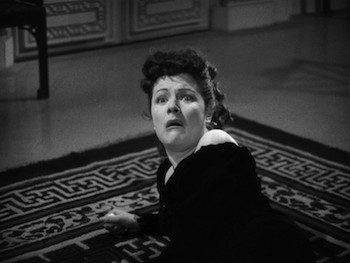
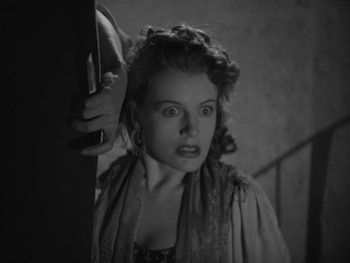
left to right: The Man in Grey, Madonna of the Seven Moons
Jamie S. Rich is a novelist and comic book writer. He is best known for his collaborations with Joelle Jones, including the hardboiled crime comic book You Have Killed Me, the challenging romance 12 Reasons Why I Love Her, and the 2007 prose novel Have You Seen the Horizon Lately?, for which Jones did the cover. All three were published by Oni Press. His most recent projects include the futuristic romance A Boy and a Girl with Natalie Nourigat; Archer Coe and the Thousand Natural Shocks, a loopy crime tale drawn by Dan Christensen; and the horror miniseries Madame Frankenstein, a collaboration with Megan Levens. Follow Rich's blog at Confessions123.com.
|
| Popular Reviews |
| Sponsored Links |
|
|
| Sponsored Links |
|
|
| Release List | Reviews | Shop | Newsletter | Forum | DVD Giveaways | Blu-Ray | Advertise |
|
Copyright 2024 DVDTalk.com All Rights Reserved. Legal Info, Privacy Policy, Terms of Use,
Manage Preferences,
Your Privacy Choices | |||||||









